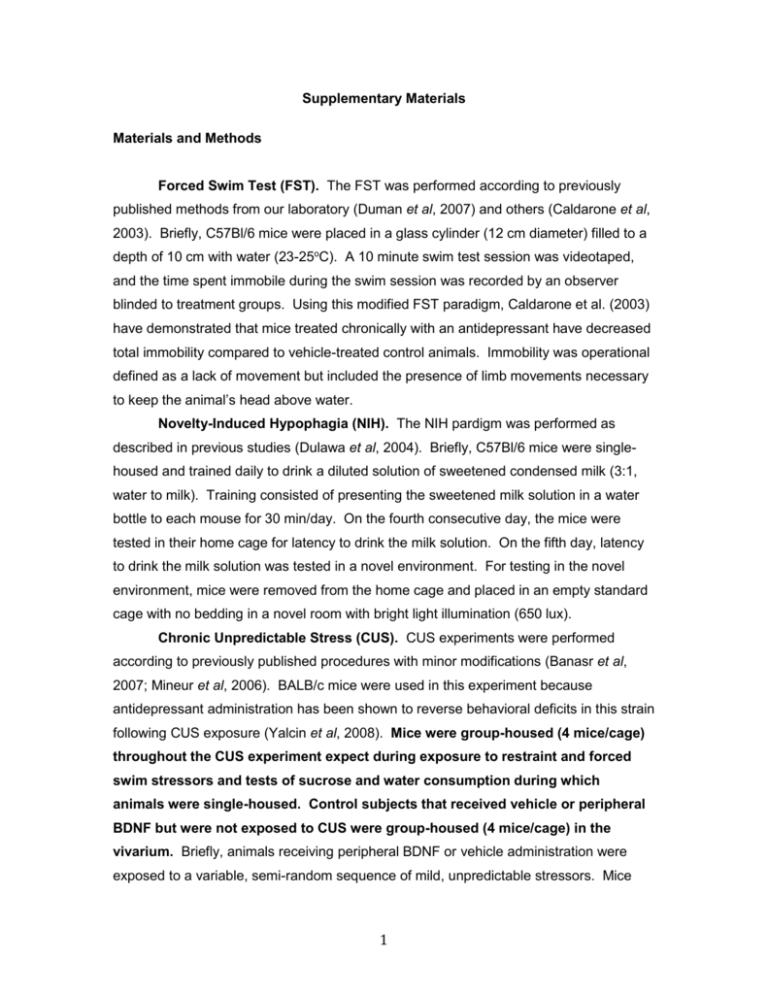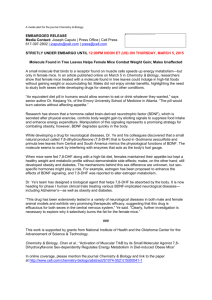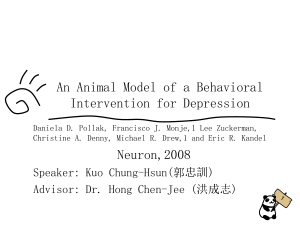Supplementary Information (doc 456K)
advertisement

Supplementary Materials Materials and Methods Forced Swim Test (FST). The FST was performed according to previously published methods from our laboratory (Duman et al, 2007) and others (Caldarone et al, 2003). Briefly, C57Bl/6 mice were placed in a glass cylinder (12 cm diameter) filled to a depth of 10 cm with water (23-25oC). A 10 minute swim test session was videotaped, and the time spent immobile during the swim session was recorded by an observer blinded to treatment groups. Using this modified FST paradigm, Caldarone et al. (2003) have demonstrated that mice treated chronically with an antidepressant have decreased total immobility compared to vehicle-treated control animals. Immobility was operational defined as a lack of movement but included the presence of limb movements necessary to keep the animal’s head above water. Novelty-Induced Hypophagia (NIH). The NIH pardigm was performed as described in previous studies (Dulawa et al, 2004). Briefly, C57Bl/6 mice were singlehoused and trained daily to drink a diluted solution of sweetened condensed milk (3:1, water to milk). Training consisted of presenting the sweetened milk solution in a water bottle to each mouse for 30 min/day. On the fourth consecutive day, the mice were tested in their home cage for latency to drink the milk solution. On the fifth day, latency to drink the milk solution was tested in a novel environment. For testing in the novel environment, mice were removed from the home cage and placed in an empty standard cage with no bedding in a novel room with bright light illumination (650 lux). Chronic Unpredictable Stress (CUS). CUS experiments were performed according to previously published procedures with minor modifications (Banasr et al, 2007; Mineur et al, 2006). BALB/c mice were used in this experiment because antidepressant administration has been shown to reverse behavioral deficits in this strain following CUS exposure (Yalcin et al, 2008). Mice were group-housed (4 mice/cage) throughout the CUS experiment expect during exposure to restraint and forced swim stressors and tests of sucrose and water consumption during which animals were single-housed. Control subjects that received vehicle or peripheral BDNF but were not exposed to CUS were group-housed (4 mice/cage) in the vivarium. Briefly, animals receiving peripheral BDNF or vehicle administration were exposed to a variable, semi-random sequence of mild, unpredictable stressors. Mice 1 were transferred to new cages and exposed to stressors in a behavioral space outside of the colony. Following stress exposure, animals were returned to their home cages within the animal colony. Following exposure to stressors that required animals be separated (i.e. forced swim test and restraint), these subjects were returned to their original cages with the same cagemates that they were group housed with throughout the duration of the CUS paradigm. The exact stressors, duration of stress exposure, and sequence of exposure is shown in Supplementary Table 1. Three stressors were applied daily: once in the morning (beginning at 9:00AM), once in the afternoon (beginning at 2:00 PM), and overnight. Stress exposure began one day after implantation of the mini-osmotic pump and lasted for the duration of the experiment. This sequence of stressors has been shown previously to reduce sucrose consumption compared to non-stressed controls (Banasr et al, 2007) and was adapted from earlier studies (Willner et al, 1987). Sucrose consumption was evaluated following 12 days of CUS exposure in order to determine the long-term consequences of chronic, peripheral BDNF administration on stress-induced anhedonia (adapted from Gourley et al, 2008). Briefly, mice were habituated to a 1% w/v sucrose solution for 2 days (days 8 & 9 of chronic BDNF or saline treatment). Animals were then returned to water drinking and given one hour of sucrose access following modest (4, 14, then 19 hrs) water restriction to habituate animals to water restriction (adapted from Gourley et al, 2008; Willner et al, 1996) and prevent neophobia during testing. On the test day, each mouse was allowed access to the sucrose solution in the home cage for 1 hr in the absence of cagemates. The 3 cagemates who were not being tested were group housed in a clean cage within the colony room. Each mouse had 1 hr access to the sucrose solution such that the average deprivation period across each cage of 4 mice was 13.5 hrs. For example, in a cage of 4 mice, the deprivation period would range from 12, for the first mouse tested, to 15 hours for the last mouse tested. Stressed and non-stressed subjects that received vehicle or peripheral BDNF experienced the same protocol for testing sucrose consumption. Because testing order could influence sucrose consumption, an ANOVA using testing order as the independent measure was performed to confirm no effects of this variable on consumption (F<1). Testing was repeated the following day, except that mice were given access to water instead of sucrose solution in order to verify that peripheral BDNF did not influence thirst levels. Body weights did not differ at the time of the test. Total sucrose consumption on test day was normalized to body weight. Control animals that 2 were not exposed to CUS and that received chronic, peripheral BDNF or saline were group housed in their home cages within the animal colony. These controls received the same temporal and spatial sequence of habituation and test days that the stressed animals experienced (i.e. habituation on days 8 & 9 of BDNF or saline treatment followed by a modest water restriction and then a sucrose test on day 13 and water test on day 14 of treatment). There were no rank order effects of testing order (data not shown) or significant differences in water consumption between treatments (see Supplementary Figure 1). Furthermore, there were no significant differences in bodyweights on test days. Elevated Plus Maze (EPM). The method used for evaluating anxiety-like behavior in the EPM was adapted from Lister (1987). The maze was elevated 50 cm from the floor and consisted of two open arms (6.0 cm x 35.0 cm) and two enclosed arms (6.0 cm x 35.0 cm x 15.25 cm) that all extended from a common platform (6.5 cm x 6.5 cm). The EPM was illuminated equally on all four arms. Mice were placed in the center of the maze facing an open arm and were allowed to explore the maze for 5 minutes. A blinded observer recorded the total time spent in each arm as well as the number of entries into each arm. Entries were operational defined as occurring when all four paws crossed into a particular arm (Pellow et al, 1985). The EPM was conducted under dim lighting conditions (~25 lx). Open Field Test (OFT). In this paradigm, a mouse was placed into the center of an open field (76.5 cm × 76.5 cm × 40 cm) constructed of Plexiglas and allowed to explore for 10 minutes. Mice were videotaped and activity was measured using the Noldus (Alexandria, VA) EthoVisionPro Video Tracking System in the absence of the observer. The duration and distance traveled in the center (10 cm × 10 cm square in middle of the open field) versus the periphery of the open field were measured and used as indices of anxiety (i.e., more time spent and more distance traveled in the center of the open field equals less anxiety). The OFT was conducted in a brightly illuminated (650 lux) room. Locomotor Activity. Total locomotor activity was measured for one hour by video tracking software (EthoVisionPro software, Noldus) in standard mouse cages. Locomotor activity was videotaped in the absence of the observer. BDNF Enzyme-linked Immunosorbent Assays (ELISAs) 3 Separate cohorts of animals were used for the biochemical studies. These animals received the same chronic BDNF or saline treatment as those subjects used in the behavioral assays. A separate group of animals was used to collect hippocampus and striatal tissue for the ELISA and in situ hybridization studies (i.e., one hemisphere for ELISA and one hemisphere for in situ hybridization). ChemiKine BDNF Sandwich ELISAs (Chemicon, Temecula, CA) were performed according to the manufacturers’ instructions. In short, BDNF standards and tissue homogenates (hippocampus and ventral striatum) or blood plasma from mice receiving chronic, peripheral BDNF or saline were incubated overnight at 4oC in a 96-well dish pre-coated with rabbit anti-human BDNF polyclonal antibody. Plates were then incubated with 100 µl of biotinylated mouse anti-BDNF monoclonal antibody (2 hours) followed by 100 µl of streptavidin-HRP conjugate solution (1 hour). Finally, the plates were incubated in peroxidase substrate and tetramethylbenzidine solution to produce a colorimetric reaction. The reaction was stopped with addition of 1 M HCl. Absorbance was measured at 450 nm using a microplate reader. Sample BDNF concentrations were then determined by non-linear regression from the standard curves. In Situ Hybridization (ISH) Analysis ISH was performed using radiolabeled riboprobes according to conventional protocols with minor modifications (Nibuya et al, 1995). Briefly, coronal sections of frozen brain (16 µm) were cut on a cryostat and stored at ~70°C. Tissue sections were thaw-mounted on RNase-free Probon slides (Fisher), fixed, and dried. ISH was performed using radiolabeled riboprobes according to conventional protocols with minor modifications (Nibuya et al, 1995). Riboprobes were generated by PCR amplification using gene-specific primers. The reverse primer included a T7 template sequence. Whole rat brain cDNA was used as the template for PCR, which was performed in a realtime PCR instrument (SmartCycler; Cepheid, Sunnyvale, CA) using the Quantitect Sybr Green PCR kit (Qiagen). PCR product was purified by ethanol precipitation and was resuspended in TE buffer. One microgram of the 300 bp PCR product was used to produce radiolabeled riboprobe using a T7-based in vitro transcription kit (Megashortscript; Ambion). All riboprobes were verified by sequencing of the PCR product. ISH images were quantified using NIH Image software and statistical analysis was performed using Statview. Linearity of densitometry was verified using 14C step standards. For each animal, both hemispheres of 3 coronal sections were analyzed for 4 a total of 6 determinations, from which the mean was determined. Bromodeoxyuridine (BrdU) Immunohistochemistry and Quantification Immunostaining was performed on free-floating sections (35 µm) according to previously published procedures (Madsen et al, 2005). Mice were transcardially perfused with ice-cold phosphate-buffered saline (PBS) followed by 4% paraformaldehyde. Brains were equilibrated in 30% sucrose and cut into 35 µm sections on a freezing microtome. Every sixth section collected from the prefrontal cortex or hippocampus was processed for immunoperoxidase staining. This spacing ensured that the same cell is not counted in two consecutive sections. Briefly, free-floating sections were denatured, incubated with blocking buffer, and then incubated with mouse antiBrdU antibody (1:100; Becton Dickinson, Franklin Lakes, NJ) in blocking buffer overnight (4°C). Sections were then incubated with biotinylated goat anti-mouse IgG (1:200) (Vector Laboratories, Burlingame, CA) for 1 hour followed by amplification and visualization with diaminobenzidine according to manufacturers specifications (Vector Laboratories). Neurogenesis was measured by counting BrdU-positive (BrdU+) cells in the subgranular zone (SGZ) of the dentate gyrus or the prelimibic cortex. The rates of proliferation and survival of neural progenitor cells were determined using Stereo Investigator software (MicroBrightField, Williston, VT). A modified, unbiased stereological procedure was used by an observer blinded to treatment group in order to quantify BrdU+ cells as described previously (Madsen et al, 2005; Malberg et al, 2000). For proliferation cell counts, a BrdU+ cell was counted as being in the SGZ if it was touching or within the SGZ. BrdU+ cells that were located more than two cell diameters away from the SGZ were excluded. For survival cell counts, all BrdU+ cells that were located within the granule layer of the dentate gyrus were scored. Brdu+ cells that were located more than two cells away from the granule layer were excluded. BrdU+ cells were counted under high-power magnification (400x and 1000x) using a light microscope. For proliferation and survival cell counts in the prelimibic cortex, a 0.5 x 0.5 mm2 contour was placed over the prelimbic cortex and all BrdU+ cells within the contour were counted under high-power magnification. Every sixth section was counted throughout the extent of the hippocampus or prelimbic cortex. The sum of BrdU+ cells across sections was determined and multiplied by 6 in order to obtain the total number of BrdU+ cells in the entire dentate gyrus or prelimbic cortex. 5 Immunoblotting A separate group of animals that received the same chronic, peripheral BDNF or saline treatment as those subjects tested in behavioral assays were used for the Western blot studies. Standard Western blotting techniques were used to quantify CREB, pCREB (ser133), ERK1/2, and pERK1/2 (for more detail see Supplementary Materials) (Kodama et al, 2005). The hippocampus and ventral striatum were rapidly dissected and immediately frozen on dry ice. Tissue homogenates were made from frozen tissue sonicated in a solution of 1% sodium dodecyl sulfate (SDS) containing a cocktail of protease and phosphatase inhibitors (Sigma, MO). Total protein (20 mg) was loaded into each lane of a tris-glycine gel (Invitrogen, Carlsbad, CA) for electrophoretic separation. The Odyssey imaging system (LI-COR, Lincoln, NE) was used to scan blots and bands were analyzed using fluorescent densitometry analysis. Data were normalized to -actin and subsquently converted to a percent of control samples from the same membrane in order to control for variance between gels. Findings were confirmed by analyzing the same samples on independent gels. All identified bands migrated in patterns consistent with the expected molecular weights for the probed proteins. 6 Supplementary Table 1: Mice were exposed to three stressors per day (AM, PM, and overnight exposure). The duration of exposure to each stressor is indicated in parentheses next to the specific stressor. Animals were exposed to 14 hours of overnight stress (6pm-8am). Sucrose and water consumption were determined in stressed and non-stressed animals following 12 and 13 days, respectively, of peripheral BDNF or saline administration. 7 Supplementary Figure 1 Supplementary Figure 2: Stress exposure does not change water consumption in mice receiving vehicle or peripheral BDNF. Total water consumption normalized to bodyweight (mean±SEM) is displayed for stressed and non-stressed animals receiving saline or 8.0 µg/24 hr BDNF. No significant effects of treatment or stress were found using a two-way ANOVA. n = 10-16 mice/treatment. 8 Supplementary Figure 2 Supplementary Figure 2: Peripheral BDNF administration does not affect total distance traveled in the perimeter or center zones of a novel, open field environment. Total duration (mean±SEM) spent in the center (P = 0.95) or the perimeter (P = 0.87) of an open field is not significantly different between mice receiving peripheral 8.0µg/24 hr BDNF (n = 12) when compared to saline-treated controls (n = 15). 9 Supplementary Materials References Banasr M, Valentine GW, Li XY, Gourley SL, Taylor JR, Duman RS (2007). Chronic unpredictable stress decreases cell proliferation in the cerebral cortex of the adult rat. Biol Psychiatry 62(5): 496-504. Caldarone BJ, Karthigeyan K, Harrist A, Hunsberger JG, Wittmack E, King SL, et al (2003). Sex differences in response to oral amitriptyline in three animal models of depression in C57BL/6J mice. Psychopharmacology (Berl) 170(1): 94-101. Dulawa SC, Holick KA, Gundersen B, Hen R (2004). Effects of chronic fluoxetine in animal models of anxiety and depression. Neuropsychopharmacology 29(7): 1321-1330. Duman CH, Schlesinger L, Kodama M, Russell DS, Duman RS (2007). A Role for MAP Kinase Signaling in Behavioral Models of Depression and Antidepressant Treatment. Biol Psychiatry 61(5): 661-670. Gourley SL, Kiraly DD, Howell JL, Olausson P, Taylor JR (2008). Acute hippocampal brain-derived neurotrophic factor restores motivational and forced swim performance after corticosterone. Biol Psychiatry 64(10): 884-890. Kodama M, Russell DS, Duman RS (2005). Electroconvulsive seizures increase the expression of MAP kinase phosphatases in limbic regions of rat brain. Neuropsychopharmacology 30(2): 360-371. Lister RG (1987). The use of a plus-maze to measure anxiety in the mouse. Psychopharmacology (Berl) 92(2): 180-185. Madsen TM, Yeh DD, Valentine GW, Duman RS (2005). Electroconvulsive seizure treatment increases cell proliferation in rat frontal cortex. Neuropsychopharmacology 30(1): 27-34. Malberg JE, Eisch AJ, Nestler EJ, Duman RS (2000). Chronic antidepressant treatment increases neurogenesis in adult rat hippocampus. J Neurosci 20(24): 9104-9110. Mineur YS, Belzung C, Crusio WE (2006). Effects of unpredictable chronic mild stress on anxiety and depression-like behavior in mice. Behav Brain Res 175(1): 43-50. Nibuya M, Morinobu S, Duman RS (1995). Regulation of BDNF and trkB mRNA in rat brain by chronic electroconvulsive seizure and antidepressant drug treatments. J Neurosci 15(11): 7539-7547. Pellow S, Chopin P, File SE, Briley M (1985). Validation of open:closed arm entries in an elevated plus-maze as a measure of anxiety in the rat. J Neurosci Methods 14(3): 149167. 10 Willner P, Moreau JL, Nielsen CK, Papp M, Sluzewska A (1996). Decreased hedonic responsiveness following chronic mild stress is not secondary to loss of body weight. Physiol Behav 60(1): 129-134. Willner P, Towell A, Sampson D, Sophokleous S, Muscat R (1987). Reduction of sucrose preference by chronic unpredictable mild stress, and its restoration by a tricyclic antidepressant. Psychopharmacology (Berl) 93(3): 358-364. Yalcin I, Belzung C, Surget A (2008). Mouse strain differences in the unpredictable chronic mild stress: a four-antidepressant survey. Behav Brain Res 193(1): 140-143. 11






